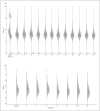Modern-day clinical course of type 1 diabetes mellitus after 30 years' duration: the diabetes control and complications trial/epidemiology of diabetes interventions and complications and Pittsburgh epidemiology of diabetes complications experience (1983-2005)
- PMID: 19636033
- PMCID: PMC2866072
- DOI: 10.1001/archinternmed.2009.193
Modern-day clinical course of type 1 diabetes mellitus after 30 years' duration: the diabetes control and complications trial/epidemiology of diabetes interventions and complications and Pittsburgh epidemiology of diabetes complications experience (1983-2005)
Abstract
Background: Clinical treatment goals of type 1 diabetes mellitus (T1DM) have changed since the Diabetes Control and Complications Trial (DCCT) demonstrated reduced long-term complications with intensive diabetes therapy. There have been few longitudinal studies to describe the clinical course of T1DM in the age of intensive therapy. Our objective was to describe the current-day clinical course of T1DM.
Methods: An analysis of the cumulative incidence of long-term complications was performed. The DCCT (1983-1993) assigned patients to conventional or intensive therapy. Since 1993, the DCCT has been observational, and intensive therapy was recommended for all patients. The Pittsburgh Epidemiology of Diabetes Complications (EDC) study is an observational study of patients with T1DM from Allegheny County, Pennsylvania. The study population comprised the DCCT T1DM cohort (N = 1441) and a subset of the EDC cohort (n = 161) selected to match DCCT entry criteria. In the DCCT, intensive therapy aimed for a near-normal glycemic level with 3 or more daily insulin injections or an insulin pump. Conventional therapy, with 1 to 2 daily insulin injections, was not designed to achieve specific glycemic targets. Main outcome measures included the incidences of proliferative retinopathy, nephropathy (albumin excretion rate >300 mg/24 h, creatinine level >or=2 mg/dL [to convert to micromoles per liter, multiply by 88.4], or renal replacement), and cardiovascular disease.
Results: After 30 years of diabetes, the cumulative incidences of proliferative retinopathy, nephropathy, and cardiovascular disease were 50%, 25%, and 14%, respectively, in the DCCT conventional treatment group, and 47%, 17%, and 14%, respectively, in the EDC cohort. The DCCT intensive therapy group had substantially lower cumulative incidences (21%, 9%, and 9%) and fewer than 1% became blind, required kidney replacement, or had an amputation because of diabetes during that time.
Conclusion: The frequencies of serious complications in patients with T1DM, especially when treated intensively, are lower than that reported historically.
Trial registration: ClinicalTrials.gov NCT00360815 NCT00360893.
Figures


References
-
- The DCCT Research Group The Diabetes Control and Complications Trial (DCCT): design and methodologic considerations for the feasibility phase. Diabetes. 1986;35(5):530–545. - PubMed
-
- Epidemiology of Diabetes Interventions and Complications (EDIC) Research Group Epidemiology of Diabetes Interventions and Complications (EDIC): design, implementation, and preliminary results of a long-term follow-up of the Diabetes Control and Complications Trial cohort. Diabetes Care. 1999;22(1):99–111. - PMC - PubMed
-
- Reichard P, Nilsson B-Y, Rosenqvist U. The effect of long-term intensified insulin treatment on the development of microvascular complications of diabetes mellitus. N Engl J Med. 1993;329(5):304–309. - PubMed
-
- The Diabetes Control and Complications Trial Research Group The effect of intensive treatment of diabetes on the development and progression of long-term complications in insulin-dependent diabetes mellitus. N Engl J Med. 1993;329(14):977–986. - PubMed
Publication types
MeSH terms
Substances
Associated data
Grants and funding
LinkOut - more resources
Full Text Sources
Other Literature Sources
Medical

